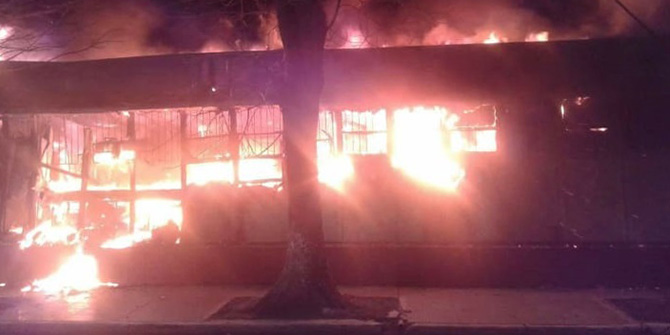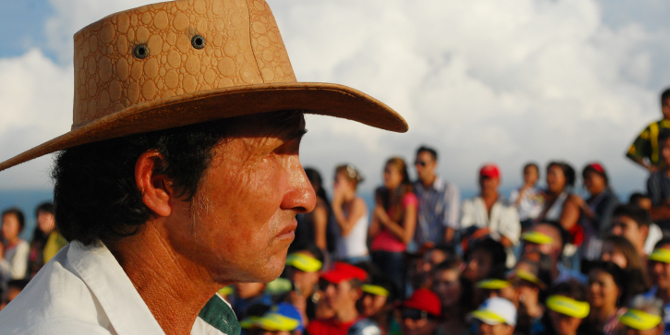 The case of Health and Community Action Centre (CESAC) #14 in Buenos Aires, yet to reopen after burning down in August 2018, is a reflection of the kind of state neglect that has damaged Argentina’s public health and education in recent years. But mobilisation of the surrounding community via a local health board has also shown that sustained and organised public pressure can counteract wider austerity and foster real improvements in the quality of public services, writes Adriana Laura Massidda (De Montfort University).
The case of Health and Community Action Centre (CESAC) #14 in Buenos Aires, yet to reopen after burning down in August 2018, is a reflection of the kind of state neglect that has damaged Argentina’s public health and education in recent years. But mobilisation of the surrounding community via a local health board has also shown that sustained and organised public pressure can counteract wider austerity and foster real improvements in the quality of public services, writes Adriana Laura Massidda (De Montfort University).
Argentina recently held open primaries for the presidential elections to be held on 27 October, 2019. After a four-year social and economic debacle, the country will have its first opportunity since 2015 to reorient or replace policies that have badly hit the poor and even the middle classes all across the country.
The story of Health and Community Action Centre (CESAC) #14 in southern Buenos Aires, which was burnt down a year before the primaries, serves as testament to the avoidable tragedies of the incumbent Macri government’s ill-conceived austerity programme. At the same time, however, the relentless community campaigning that emerged from its ashes reveals how decades of experience in participatory planning and grassroots self-organisation can bring about and sustain effective resistance.

Health and Community Action Centres and Argentine social policy
CESACs are community-based medical practices for primary care within the city of Buenos Aires. Staffed by inter-disciplinary teams, they report to local hospitals and focus both on physical health and on social and community wellbeing. As such, they provide a wide variety of services:
- General practice, paediatrics, obstetrics, gynaecology, dentistry, psychology, and nutrition
- Distribution of medicines
- Pre- and post-natal support for families
- Specific awareness-raising initiatives on health-related issues such as disease prevention, family planning, and healthy lifestyles
The approach is personalised and free of charge, with financial support coming from the city government. CESAC #14 in particular serves the districts of Parque Avellaneda and Villa Lugano, especially the nearby community of Villa Cildáñez. These are amongst the most vulnerable areas in Buenos Aires.
CESACs have been struggling for decades due to shortages of staff, poor building maintenance and a general lack of resources, but recent years have been especially difficult.
In November 2017, for example, a young man died in nearby CESAC #3 because the centre lacked an ambulance and was under-staffed. In July 2018 the local government attempted to close CESAC #28, also in the Villa Lugano district. Yet, ever since Villa Lugano first was first populated, local governments have shied away from providing a hospital in the area. Although the Cecilia Grierson Hospital was built nearby and officially opened in 2009, it recently reached its tenth anniversary without having become operational.
CESAC #14: out of the ashes
For its part, CESAC #14 faced continual material challenges, not least because its original premises were built in the 1970s as a temporary solution. Constructed using cheap and even toxic materials like asbestos, drywall, and cardboard, these buildings had since suffered flooding on multiple occasions, whereas gas and electricity systems were deemed hazardous by health and safety officers. Space was also a problem from the outset, with workers forced to improvise offices in areas designed for other purposes.
Then, on 25 August 2018, the centre caught fire during the night. The fire alarms failed to go off, whereas the night-watchmen had been laid off due to budget cuts. When firemen arrived at the site, the destruction was too severe for the premises to be saved. All of the facility’s equipment was lost, as were patients’ clinical histories, still being recorded on paper.

Since then, CESAC #14 has been working out of premises that are even more precarious: a set of temporary trailers and a few rooms provided by a local nursery. Essential services such as electricity continue to fail. Opening hours are reduced. There are no waiting rooms. The dental practice and pharmacy have no space to operate. But remarkably, despite these considerable hardships and constraints, thousands of residents continue to receive attention at the centre.
Official and community responses
The initial reaction of local government was to try to disperse the CESAC #14 team to a number of other health centres. Residents and professionals knew, however, that this would mean the permanent dismantling of this much-needed centre. In response, they set up a local health board (mesa de salud) to follow-up on the issue, and through this initial mobilisation were able to secure the continuity of the team.
There then followed a long series of negotiations and unfulfilled promises about the construction of a permanent home for the centre. At the time of the fire, the local government was constructing a larger building beside the CESAC that would include laboratories and equipment for regular check-ups, as well as an accident and emergency department. Construction of a new building specifically for the CESAC had also already begun.
After the fire, however, residents and health workers discovered that these new premises were to be about 30 per cent smaller than the previous building, which was itself too small for an area undergoing continual and rapid population growth. Neither did it meet even the most basic municipal planning regulations in areas like wheelchair access, fire escapes, or natural ventilation. On top of all that, the construction company which won the public tender went bankrupt, and delays to payments between various parties saw the local government repeatedly postpone the opening of the new premises.

The health board then devoted itself to making sure the building was not only completed properly but also designed to fulfil its purpose effectively. For over a year it has held weekly meetings and numerous public activities to maintain the visibility of the issue. Recent months have seen a mass “hug of support” for the centre, an Argentine tea party with stalls and workshops, and a birthday-party demonstration to mark the first anniversary of the fire.
Health board participants have obtained permission to make regular visits to the site in order to oversee the works. They have also managed to bring key problems in the building’s design to the attention of officials of various ranks, effectively forcing the government to rectify them. More specifically, neither of the two buildings under construction before the fire had been designed through participatory planning; the health board aims to ensure that they will be. Overall, the board has successfully used sustained public pressure to have its voice heard by the authorities.
Self-organisation in southern Buenos Aires
While the work of this particular health board is unique, it also taps into a long tradition of self-organisation in southern Buenos Aires. Since the early twentieth century, residents of the area have combined public visibility and careful negotiation with local authorities in their efforts to promote wellbeing and improve the built environment in which they live.
In the late 1950s, for example, a local group campaigned intensely and successfully for the municipality to channel the contaminated Cildáñez stream underground so that it would no longer have a noxious impact on residents’ health. Three decades later, another group started a collective campaign to clear-up the Avellaneda park after it was filled with debris by the last dictatorship during the the so-called National Reorganisation Process (1976-83). As the project grew, the group began to run the park via Participatory Planning and Associative Management, which uses collective decision-making as a tool to overcome the limitations of representational democracy. The same group continues to expand even today, with some of it members also forming part of the health board.
CESACs and the state of social services in Argentina
Of course, the fire in CESAC #14 is only one minor instance of the kind of state neglect that has had wider and deeper effects on Argentina’s public health and education in recent years. This also transcends the administration of the Buenos Aires city district.
Within a month of the CESAC fire, an explosion at Primary School #49 in Moreno (Greater Buenos Aires) killed two workers. Teachers and parents had been denouncing poor maintenance of the building for a year, ever since an incident in August 2018 which saw a poorly installed gas heater explode just minutes before the school was to open for the morning. The lessons, however, were not learnt, and in May 2019 another explosion occurred in another school of the same district (though thankfully no one was killed).
Likewise in terms of the health sector, numerous examples speak to a larger picture of neglect. Barely a month after the fire in CESAC #14 the national government dissolved the Ministry of Health by merging it with the Ministry of Social Development, laid off 40 doctors in Hospital Posadas in western Buenos Aires (following earlier mass layoffs), and closed down a community health centre in the shantytown of Ciudad Oculta.
These moves were supposedly a means of reducing costs, yet they reflect a deep lack of understanding about the institutions and human resources that are essential in sustaining citizens’ wellbeing at the local level. Stories like that of CESAC #14 also demonstrate that the problem lies not only in austerity itself, but also in poor management of time and resources. Had it not been for the residents’ efforts and attention, in fact, the CESAC building would have lacked essential features – if indeed it had been finished at all. In this sense, the achievements of the CESAC #14 health board are part of a more general picture of civil counter-action.
Anyone surprised by the results of the recent primaries, which saw an overwhelming defeat for the ruling party, should bear in mind that recent years have seen recession, rising unemployment, and rampant inflation combined with micro-scale tragedies of neglect like that of CESAC #14. As Parque Avellaneda residents continue their campaign for the completion of the centre’s new premises, Argentina may be heading for a change of direction that could help to prevent such tragedies in future.
Notes:
• The views expressed here are of the authors and do not reflect the position of the Centre or of the LSE
• Please read our Comments Policy before commenting





